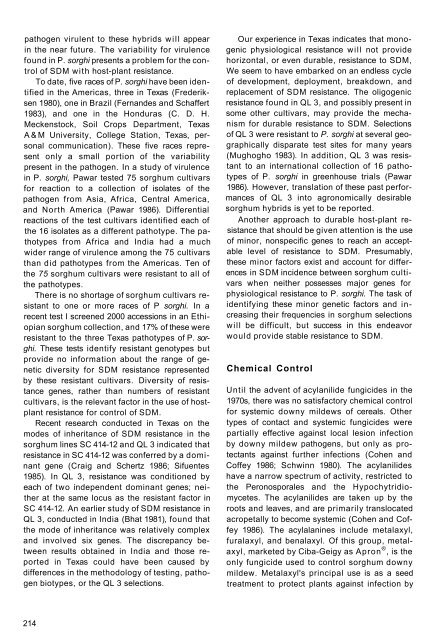Sorghum Diseases in India
Sorghum Diseases in India
Sorghum Diseases in India
You also want an ePaper? Increase the reach of your titles
YUMPU automatically turns print PDFs into web optimized ePapers that Google loves.
pathogen virulent to these hybrids will appear<br />
<strong>in</strong> the near future. The variability for virulence<br />
found <strong>in</strong> P. sorghi presents a problem for the control<br />
of SDM with host-plant resistance.<br />
To date, five races of P. sorghi have been identified<br />
<strong>in</strong> the Americas, three <strong>in</strong> Texas (Frederiksen<br />
1980), one <strong>in</strong> Brazil (Fernandes and Schaffert<br />
1983), and one <strong>in</strong> the Honduras (C. D. H.<br />
Meckenstock, Soil Crops Department, Texas<br />
A&M University, College Station, Texas, personal<br />
communication). These five races represent<br />
only a small portion of the variability<br />
present <strong>in</strong> the pathogen. In a study of virulence<br />
<strong>in</strong> P. sorghi, Pawar tested 75 sorghum cultivars<br />
for reaction to a collection of isolates of the<br />
pathogen from Asia, Africa, Central America,<br />
and North America (Pawar 1986). Differential<br />
reactions of the test cultivars identified each of<br />
the 16 isolates as a different pathotype. The pathotypes<br />
from Africa and <strong>India</strong> had a much<br />
wider range of virulence among the 75 cultivars<br />
than did pathotypes from the Americas. Ten of<br />
the 75 sorghum cultivars were resistant to all of<br />
the pathotypes.<br />
There is no shortage of sorghum cultivars resistant<br />
to one or more races of P sorghi. In a<br />
recent test I screened 2000 accessions <strong>in</strong> an Ethiopian<br />
sorghum collection, and 17% of these were<br />
resistant to the three Texas pathotypes of P. sorghi.<br />
These tests identify resistant genotypes but<br />
provide no <strong>in</strong>formation about the range of genetic<br />
diversity for SDM resistance represented<br />
by these resistant cultivars. Diversity of resistance<br />
genes, rather than numbers of resistant<br />
cultivars, is the relevant factor <strong>in</strong> the use of hostplant<br />
resistance for control of SDM.<br />
Recent research conducted <strong>in</strong> Texas on the<br />
modes of <strong>in</strong>heritance of SDM resistance <strong>in</strong> the<br />
sorghum l<strong>in</strong>es SC 414-12 and QL 3 <strong>in</strong>dicated that<br />
resistance <strong>in</strong> SC 414-12 was conferred by a dom<strong>in</strong>ant<br />
gene (Craig and Schertz 1986; Sifuentes<br />
1985). In QL 3, resistance was conditioned by<br />
each of two <strong>in</strong>dependent dom<strong>in</strong>ant genes; neither<br />
at the same locus as the resistant factor <strong>in</strong><br />
SC 414-12. An earlier study of SDM resistance <strong>in</strong><br />
QL 3, conducted <strong>in</strong> <strong>India</strong> (Bhat 1981), found that<br />
the mode of <strong>in</strong>heritance was relatively complex<br />
and <strong>in</strong>volved six genes. The discrepancy between<br />
results obta<strong>in</strong>ed <strong>in</strong> <strong>India</strong> and those reported<br />
<strong>in</strong> Texas could have been caused by<br />
differences <strong>in</strong> the methodology of test<strong>in</strong>g, pathogen<br />
biotypes, or the QL 3 selections.<br />
214<br />
Our experience <strong>in</strong> Texas <strong>in</strong>dicates that monogenic<br />
physiological resistance will not provide<br />
horizontal, or even durable, resistance to SDM,<br />
We seem to have embarked on an endless cycle<br />
of development, deployment, breakdown, and<br />
replacement of SDM resistance. The oligogenic<br />
resistance found <strong>in</strong> QL 3, and possibly present <strong>in</strong><br />
some other cultivars, may provide the mechanism<br />
for durable resistance to SDM. Selections<br />
of QL 3 were resistant to P. sorghi at several geographically<br />
disparate test sites for many years<br />
(Mughogho 1983). In addition, QL 3 was resistant<br />
to an <strong>in</strong>ternational collection of 16 pathotypes<br />
of P. sorghi <strong>in</strong> greenhouse trials (Pawar<br />
1986). However, translation of these past performances<br />
of QL 3 <strong>in</strong>to agronomically desirable<br />
sorghum hybrids is yet to be reported.<br />
Another approach to durable host-plant resistance<br />
that should be given attention is the use<br />
of m<strong>in</strong>or, nonspecific genes to reach an acceptable<br />
level of resistance to SDM. Presumably,<br />
these m<strong>in</strong>or factors exist and account for differences<br />
<strong>in</strong> SDM <strong>in</strong>cidence between sorghum cultivars<br />
when neither possesses major genes for<br />
physiological resistance to P. sorghi. The task of<br />
identify<strong>in</strong>g these m<strong>in</strong>or genetic factors and <strong>in</strong>creas<strong>in</strong>g<br />
their frequencies <strong>in</strong> sorghum selections<br />
will be difficult, but success <strong>in</strong> this endeavor<br />
would provide stable resistance to SDM.<br />
Chemical Control<br />
Until the advent of acylanilide fungicides <strong>in</strong> the<br />
1970s, there was no satisfactory chemical control<br />
for systemic downy mildews of cereals. Other<br />
types of contact and systemic fungicides were<br />
partially effective aga<strong>in</strong>st local lesion <strong>in</strong>fection<br />
by downy mildew pathogens, but only as protectants<br />
aga<strong>in</strong>st further <strong>in</strong>fections (Cohen and<br />
Coffey 1986; Schw<strong>in</strong>n 1980). The acylanilides<br />
have a narrow spectrum of activity, restricted to<br />
the Peronosporales and the Hypochytridiomycetes.<br />
The acylanilides are taken up by the<br />
roots and leaves, and are primarily translocated<br />
acropetally to become systemic (Cohen and Coffey<br />
1986). The acylalan<strong>in</strong>es <strong>in</strong>clude metalaxyl,<br />
furalaxyl, and benalaxyl. Of this group, metalaxyl,<br />
marketed by Ciba-Geigy as Apron ® , is the<br />
only fungicide used to control sorghum downy<br />
mildew. Metalaxyl's pr<strong>in</strong>cipal use is as a seed<br />
treatment to protect plants aga<strong>in</strong>st <strong>in</strong>fection by








